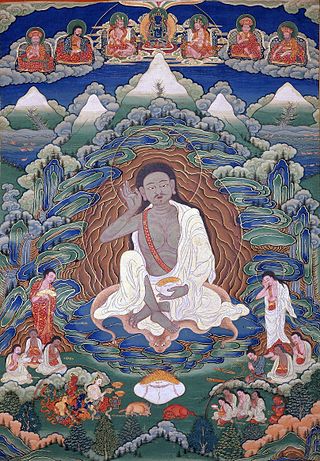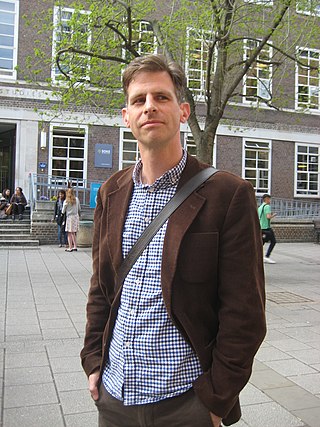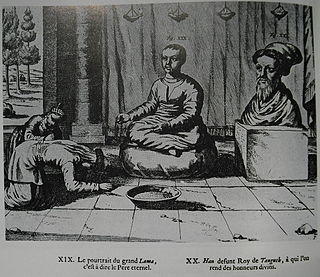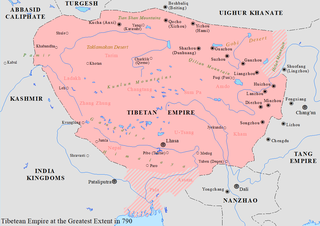
Dzogchen, also known as atiyoga, is a tradition of teachings in Indo-Tibetan Buddhism and Yungdrung Bon aimed at discovering and continuing in the ultimate ground of existence. The primordial ground is said to have the qualities of purity, spontaneity and compassion. The goal of Dzogchen is knowledge of this basis, this knowledge is called rigpa. There are numerous spiritual practices taught in the various Dzogchen systems for awakening rigpa.

Padmasambhāva, also known as Guru Rinpoche and the Lotus from Oḍḍiyāna, was a tantric Buddhist Vajra master from India who taught Vajrayana in Tibet. According to some early Tibetan sources like the Testament of Ba, he came to Tibet in the 8th century and helped construct Samye Monastery, the first Buddhist monastery in Tibet. However, little is known about the actual historical figure other than his ties to Vajrayana and Indian Buddhism.

The Gelug is the newest of the four major schools of Tibetan Buddhism. It was founded by Je Tsongkhapa (1357–1419), a Tibetan philosopher, tantric yogi and lama and further expanded and developed by his disciples.

The Kadam school of Tibetan Buddhism was an 11th century Buddhist tradition founded by the great Bengali master Atiśa (982-1054) and his students like Dromtön (1005–1064), a Tibetan Buddhist lay master. The Kadampa stressed compassion, pure discipline and study.
Uchen is the upright, block style of the Tibetan script. The name means "with a head," and is the style of the script used for printing and for formal manuscripts.

Amdo is one of the three traditional Tibetan regions, the others being U-Tsang in the west and Kham in the east. Ngari in the north-west was incorporated into Ü-Tsang. Amdo is also the birthplace of the 14th Dalai Lama. Amdo encompasses a large area from the Machu to the Drichu (Yangtze). Amdo is mostly coterminous with China's present-day Qinghai province, but also includes small portions of Sichuan and Gansu provinces.

The Rimé movement is a movement or tendency in Tibetan Buddhism which promotes non-sectarianism and universalism. Teachers from all branches of Tibetan Buddhism – Sakya, Kagyu, Nyingma, Jonang, Gelug, and Bon – have been involved in the promoting Rimé ideals.

Jamyang Khyentse Wangpo, also known by his tertön title, Pema Ösel Dongak Lingpa, was a renowned teacher, scholar and tertön of 19th-century Tibet. He was a leading figure in the Rimé movement.

Sakya PanditaKunga Gyeltsen was a Tibetan spiritual leader and Buddhist scholar and the fourth of the Five Sakya Forefathers. Künga Gyeltsen is generally known simply as Sakya Pandita, a title given to him in recognition of his scholarly achievements and knowledge of Sanskrit. He is held in the tradition to have been an emanation of Manjusri, the embodiment of the wisdom of all the Buddhas.

In Tibetan Buddhism and Bon, a ngagpa (male), or a ngagmo (female) is an ordained non-monastic practitioner of Dzogchen and Tantra. Traditionally, many Nyingma ngakpas wear uncut hair and white robes and these are sometimes called "the white-robed and uncut-hair group".
Tai Situ Changchub Gyaltsen was the founder of the Phagmodrupa Dynasty that replaced the Mongol-backed Sakya dynasty, ending Tibet under Yuan rule. He ruled most of Tibet as desi (regent) from 1354 to 1364. As a law-giver, politician and religious patron, he created a heritage that lasted centuries.

Kamalaśīla was an Indian Buddhist of Nalanda Mahavihara who accompanied Śāntarakṣita (725–788) to Tibet at the request of Trisong Detsen. He is considered one of the most important Madhyamaka authors of late Indian Buddhism although little is known about his life aside from details left in Tibetan sources. Tibetan sources refer to him, Santaraksita and Jñānagarbha as rang rgyud shar gsum meaning the “three eastern Svātantrikas” indicating their origins from Eastern India.
Matthew T. Kapstein is a scholar of Tibetan religions, Buddhism, and the cultural effects of the Chinese occupation of Tibet. He is Numata Visiting Professor of Buddhist Studies at the University of Chicago Divinity School, and Director of Tibetan Studies at the École pratique des hautes études.

The Testament of Ba or the Chronicle of Ba(Tibetan དབའ་བཞེད or སྦ་བཞེད; Wylie transliteration: dba' bzhed or sba bzhed) is a chronicle written in Classical Tibetan of the establishment of Mahayana Buddhism and Vajrayana Buddhism in Tibet, the foundation of the Samye Monastery, and includes notable events and people in Tibet's history and was written during the Tibetan Empire period. From the reigns of kings Songsten Gampo, Trisong Detsen, and to the years beyond Rapalchen's reign, a version of the chronicle, or testament, was recorded by Ba Salnang of the Ba Family, and by other scribes and members of the kings' courts. In 2008, early versions of the text were said to have been discovered in London, where two manuscript fragments possibly dating to the 9th or 10th centuries are held by the British Library.

Sam Julius van Schaik is an English tibetologist.
Jacob P. Dalton is an American professor of religion and Tibetan studies at the University of California at Berkeley, where he is the first holder of a chair endowed by the Khyentse foundation. He had previously worked as a professor at Yale University and a researcher at the British Library.
Buddhists, predominantly from India, first actively disseminated their practices in Tibet from the 6th to the 9th centuries CE. During the Era of Fragmentation, Buddhism waned in Tibet, only to rise again in the 11th century. With the Mongol invasion of Tibet and the establishment of the Mongol Yuan dynasty (1271–1368) in China, Tibetan Buddhism spread beyond Tibet to Mongolia and China. From the 14th to the 20th centuries, Tibetan Buddhism was patronized by the Chinese Ming dynasty (1368–1644) and the Manchurian Qing dynasty (1644–1912) which ruled China.

The priest and patron relationship, also written as priest-patron or cho-yon, is the Tibetan political theory that the relationship between Tibet and China referred to a symbiotic link between a spiritual leader and a lay patron, such as the historic relationship between the Dalai Lama and the Qing emperor. They were respectively spiritual teacher and lay patron rather than subject and lord. Chöyön is an abbreviation of two Tibetan words: chöney, "that which is worthy of being given gifts and alms", and yöndag, "he who gives gifts to that which is worthy".

This is a timeline of the Tibetan Empire from 6th to 9th century.
Anna Ayşe Akasoy is a German orientalist and professor of Islamic intellectual history at the Graduate Center, CUNY. Akasoy works on the intellectual history of Islam, especially of al-Andalus, on Islamic philosophy as well as on Arab veterinary medicine, falconry and hunting.














